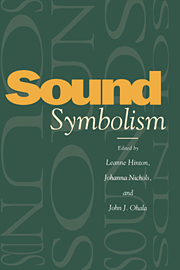Book contents
- Frontmatter
- Contents
- List of contributors
- 1 Introduction: Sound-symbolic processes
- PART I Native American languages north of Mexico
- 2 Symbolism in Nez Perce
- 3 Nootkan vocative vocalism and its implications
- 4 Relative motivation in denotational and indexical sound symbolism of Wasco-Wishram Chinookan
- PART II Native languages of Latin America
- PART III Asia
- PART IV Australia and Africa
- PART V Europe
- PART VI English
- PART VII The biological bases of sound symbolism
- Index
4 - Relative motivation in denotational and indexical sound symbolism of Wasco-Wishram Chinookan
Published online by Cambridge University Press: 04 August 2010
- Frontmatter
- Contents
- List of contributors
- 1 Introduction: Sound-symbolic processes
- PART I Native American languages north of Mexico
- 2 Symbolism in Nez Perce
- 3 Nootkan vocative vocalism and its implications
- 4 Relative motivation in denotational and indexical sound symbolism of Wasco-Wishram Chinookan
- PART II Native languages of Latin America
- PART III Asia
- PART IV Australia and Africa
- PART V Europe
- PART VI English
- PART VII The biological bases of sound symbolism
- Index
Summary
Introduction
To many, sound symbolism would appear to be at the margins of how – as Jakobson and Lévi-Strauss view inherently social facts – language is an “intervention of culture in nature” (Jakobson and Halle 1956: 17). To such a view, in fact, just as there were logically equivalent “Ding Dong,” “Pooh Pooh,” or “Bow Wow” theories of yore (see Whitney 1867: 426–427), cast in the idiom of language origin, there is a startling persistence or resurgence of essentially pre-structural views on the matter of sound symbolism. There appear to be many proponents of a notion of primordial sound iconism (in the technical, Peircean sense) for whom – notwithstanding the fact that language and culture are specific, organized semiotic systems – such iconic relations atomically motivate certain lexical forms in respect of what they denote, on grounds independent of any such sociohistorical facts of linguistic and/or cultural semiosis.
This kind of logically pre-linguistic and pre-cultural motivation of lexical denotation is, of course, what Saussure was talking about under the rubric of the “symbolic” (i.e. iconic) aspect of absolute motivation. The entire first two parts of the Cours (Saussure 1916: 97–192), by contrast, are devoted to demonstrating two truths. The first is that anything that is seriously a (denotational) sign in human language, from word-stem up through syntactic phrase, is so much more “arbitrary” in its semiotic properties than anything else, that we might as well axiomatize linguistics with this stipulation.
- Type
- Chapter
- Information
- Sound Symbolism , pp. 40 - 60Publisher: Cambridge University PressPrint publication year: 1995
- 7
- Cited by



